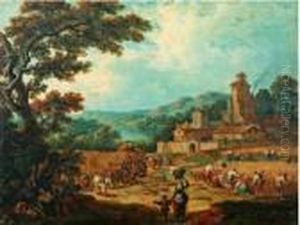Pierre Salomon Domenchin De Chavannes Paintings
Pierre Puvis de Chavannes, born Pierre-Cécile Puvis in Lyon, France, on December 14, 1824, was a prominent French painter, known for his murals that embodied the Symbolist movement. Despite the common misconception, his name does not include 'Salomon Domenchin.' His work, characterized by a serene and classical tone, eschewed the ornate styles of his contemporaries, favoring instead a more simplified and timeless approach. This approach made him a pivotal figure in the transition from traditional romanticism to the nascent modernist movements of the late 19th century. Puvis de Chavannes pursued his education in Paris, initially studying law before dedicating himself to art. He was largely self-taught, drawing inspiration from his travels across Italy, where he deeply studied Renaissance art. His murals are celebrated for their dreamlike quality and ethereal subjects, often depicting allegorical themes and mythological narratives that resonated with Symbolist poets and writers of his time. Notably, his works are housed in some of France’s most prestigious institutions, including the Panthéon and the Sorbonne, as well as museums around the world. Despite facing criticism for his unconventional techniques and idiosyncratic style during his early career, Puvis de Chavannes gained significant recognition and acclaim later in life. He was a founding member of the Société Nationale des Beaux-Arts and was awarded the Legion of Honor. His influence extended beyond France, impacting the development of muralism in the United States and other countries. Puvis de Chavannes passed away on October 24, 1898, in Paris, leaving behind a legacy that would continue to inspire artists such as Georges Seurat and Paul Gauguin, and shaping the path for future avant-garde movements.


















